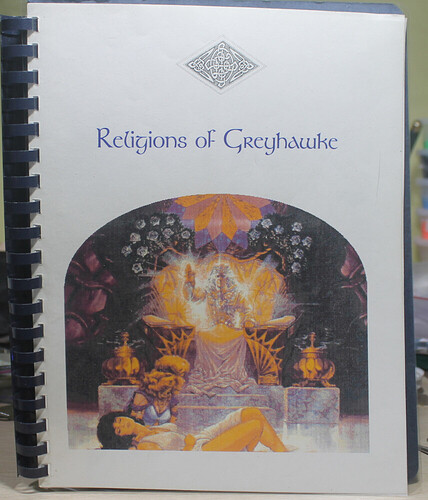Many a year ago I decided that clerics needed more. Let’s face it, there is not much to hang Brother Simor on in “Lawful Good”. So using the gods within the campaign world I created a religion gloss. A brief write up of the high points of the dogma and beliefs. Toss in some holy days, a few holy writings. A hierarchy for the church structure…
Then I came to alignment. I’m sitting there, fingers ready and the thought hits; “Why?” I just gave a rundown on the beliefs and acceptable behavior of the religion ,why does it need an alignment? The truth was it did not. I ended up extraditing alignment entirely from the game. For those that want the full argument I give it here. “Out of the Box: The Conundrum of Alignment” Today I’m talking fantasy religions.
I am rebuilding my entire religion book. (Cover above.) Most of the included religions have a level 1-7 spells list, yes I customize the spells available. Sometimes more, some times less. Terms are largely 2nd Ed. Heck, the majority of the book was done on my old Amiga 4000 long before Linux.
The methodology is simple, I’ll list it below. You run down the categories, fill them in with as much or as little needed. Is something missing, include it. Is it unnecessary, take it out. Like most of my lists it is not dogmatic. It is there to jog the brain into making a fantasy religion. I have some finished example here, and those will be getting updates soon. I’m not goiong to post the whole book to Pen & Paper
Religion Blank –
God worshiped:
Sphere of Influence:
Sacred Color:
Sacred Animal/Plant:
Place of Worship:
Worship Days:
Holy Days:
Propitiation/Sacrifices:
Holy Writings:
Favored Deities:
Disliked deities:
Favored Governments:
Disliked Governments:
Teachings and Other Information-- Worshiper Requirements –
Typical Worshiper:
Sex of worshiper:
Minimum Age:
Race:
Worship of Other Gods?:
If Yes, Any restrictions?:
Commandments–
War & Fighting:
Love and Marriage:
Duty to Liege Lord:
Self Interests:
Others Needs:
Duty to Religion:
Other:
Afterlife Expectations:
Clerical Requirements–
Name of Order:
Statement of Mission:
Sex of Cleric:
Minimum age:
Race:
Sexual Practices Allowed or Required:
Wealth and Magic Allowed:
Oaths of Ordination:
Special Attributes Needed:
Special Abilities Given by Level:
Weapons Allowed:
Armor Allowed:
Special Commandments:
Clerical Ranks–
Name – Levels
Duties:
Privileges:
Vestments:
